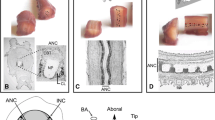Abstract
Immunohistochemical techniques were used to study the distribution of serotonin-containing neurons in the nervous system of the slug Limax valentianus. Approximately 350 serotonin-like immunoreactive cell bodies were found in the central nervous system. These were located in the cerebral, pedal, visceral and right parietal ganglia. Most serotonin-like immunoreactive neurons had small cell bodies, which were aggregated into discrete clusters. A pair of previously identified metacerebral giant cells were found on the anterior side of the cerebral ganglion, and two additional pairs of uniquely identifiable, serotonin-like immunoreactive cells were found on the posterior side of the cerebral ganglion. The whole-mount maps of these stained neurons will be useful in further physiological and biochemical studies of olfactory learning at the cellular level in Limax valentianus.




Similar content being viewed by others
References
Abrams TW (1985) Cellular studies of an associative mechanism for classical conditioning in Aplysia: activity-dependent presynaptic facilitation. In: Selverston AI (ed) Model neural networks and behavior. Plenum, New York, pp 213–235
Audesirk G (1985) Amine-containing neurons in the brain of Lymnaea stagnalis: distribution and effects of precursors. Comp Biochem Physiol 81A:359–365
Bailey CH, Hawkins RD, Chen MC, Kandel ER (1981) Interneurons involved in mediation and modulation of gill-withdrawal reflex in Aplysia. J Neurophysiol 45:358–378
Balaban PM, Vehovszky A, Maksimova OA, Zakharov IS (1987) Effect of 5,7-dihydroxytryptamine on food-aversion conditioning in the snail Helix lucorum L. Brain Res 404:201–210
Cooke IRC, Gelperin A (1988) The distribution of FMRFamide-like immunoreactivity in the nervous system of the slug Limax maximus. Cell Tissue Res 253:69–76
Gelperin A (1986) Complex associative learning in small neural networks. Trends Neurosci 9:323–328
Gelperin A, Rhines LD, Flores J, Tank DW (1993) Coherent network oscillations by olfactory interneurons: modulation by endogenous amines. J Neurophysiol 69:1930–1939
Hatakeyama D, Ito E (1999) Three-dimensional reconstruction and mapping of serotonin-like immunoreactive neurons in the central nervous system of the pond snail, Lymnaea stagnalis, with the confocal laser scanning microscope. Bioimages 7:1–12
Hawkins RD (1981) Interneurons involved in mediation and modulation of gill-withdrawal reflex in Aplysia. III. Identified facilitating neurons increase Ca2+ current in sensory neurons. J Neurophysiol 45:327–339
Hawkins RD (1989) Localization of potential serotonergic facilitator neurons in Aplysia by glyoxylic acid histofluorescence combined with retrograde fluorescent labeling. J Neurosci 9:4214–4226
Hawkins RD, Castellucci VF, Kandel ER (1981) Interneurons involved in mediation and modulation of gill-withdrawal reflex in Aplysia. I. Identification and characterization. J Neurophysiol 45:304–314
Hawkins RD, Kandel ER, Siegelbaum SA (1993) Learning to modulate transmitter release: themes and variations in synaptic plasticity. Annu Rev Neurosci 16:625–665
Inoue T, Watanabe S, Kirino Y (2001) Serotonin and NO complementarily regulate generation of oscillatory activity in the olfactory CNS of a terrestrial mollusk. J Neurophysiol 85:2634–263
Jahan-Parwar B, S.-Rozsa K, Salanki J, Evans ML, Carpenter DO (1987) In vivo labeling of serotonin-containing neurons by 5,7-dihydroxytryptamine in Aplysia. Brain Res 426:173–178
Kemenes GY, Elekes K, Hiripi L, Benjamin PR (1989) A comparison of four techniques for mapping the distribution of serotonin and serotonin-containing neurons in fixed and living ganglia of the snail, Lymnaea. J Neurocytol 18:193–208
Kimura T, Suzuki H, Kono E, Sekiguchi T (1998a) Mapping of interneurons that contribute to food aversive conditioning in the slug brain. Learning Memory 4:376–388
Kimura T, Toda S, Sekiguchi T, Kirino Y (1998b) Behavioral modulation induced by food odor aversive conditioning and its influence on the olfactory responses of an oscillatory brain network in the slug Limax marginatus. Learning Memory 4:365–375
Longley RD, Longley AJ (1986) Serotonin immunoreactivity of neurons in the gastropod Aplysia californica. J Neurobiol 17:339–358
Osborne NN, Cottrell GA (1971) Distribution of biogenic amines in the slug, Limax maximus. Z Zellforsch 112:15–30
Ono JK, McCaman RE (1984) Immunocytochemical localization and direct assays of serotonin-containing neurons in Aplysia. Neuroscience 11:549–560
S.-Rozsa K (1984) The pharmacology of molluscan neurons. Prog Neurobiol 23:79–150
S.-Rozsa K, Hernadi L, Kemenes GY (1986) Selective in vivo labelling of serotonergic neurones by 5,6-dihydroxytryptamine in the snail Helix pomatia L. Comp Biochem Physiol 85C:419–425
Sahley CL, Rudy JW, Gelperin A (1981) An analysis of associative learning in a terrestrial mollusc: higher-order conditioning, blocking and a transient US pre-exposure effect. J Comp Physiol 144:1–8
Sahley CL, Rudy JW, Gelperin A (1984) Associative learning in a mollusc: a comparative analysis. In: Alkon DL, Farley J (ed) Primary neural substrates of learning and behavioral change. Cambridge University Press, New York, pp 243-258
Teyke T (1996) Nitric oxide, but not serotonin, is involved in acquisition of food-attraction conditioning in the snail Helix pomatia. Neurosci Lett 206:29–32
Walker RJ (1986) Transmitters and modulators. In: Willows AOD (ed) The Mollusca, vol 9. Neurobiology and behaviour. Academic Press, New York, pp 279–485
Yamane T, Gelperin A (1987) Aminergic and peptidergic amplification of intracellular cyclic AMP levels in a molluscan neural network. Cell Mol Neurobiol 7:291–301
Yamane T, Oestericher AB, Gelperin A (1989) Serotonin-stimulated biochemical events in the procerebrum of Limax. Cell Mol Neurobiol 9:447–459
Acknowledgements
We thank Drs. Hitoshi Aonuma and Haruhiko Suzuki for technical suggestions and critical discussions.
Author information
Authors and Affiliations
Corresponding author
Additional information
This study was supported by Grants-in-Aid for Scientific Research from the Ministry of Education, Culture, Science, Sports and Technology, Japan (nos. 12307053 and 13771353)
Rights and permissions
About this article
Cite this article
Shirahata, T., Watanabe, S. & Kirino, Y. Distribution of serotonin-like immunoreactive neurons in the slug Limax valentianus . Cell Tissue Res 315, 285–290 (2004). https://doi.org/10.1007/s00441-003-0820-3
Received:
Accepted:
Published:
Issue Date:
DOI: https://doi.org/10.1007/s00441-003-0820-3




